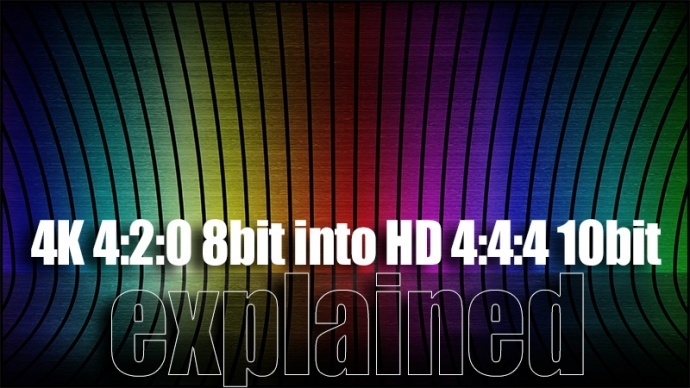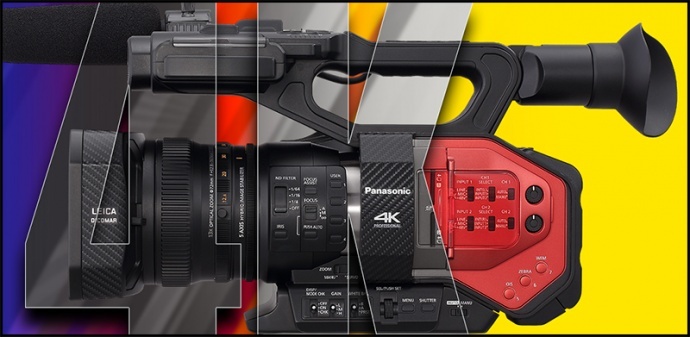当8bit 4:2:0成为10bit 4:4:4——来自Barry Green
译者按:最近开始了编译国外摄影师Blog日志的工作,可能还会有个别的翻译错误,以及理解上可能也会有些差异,像这篇还是挺好理解的。但愿将来编译能够越来越通顺和意义传达准确,谢谢啦;)

当8bit 4:2:0成为10bit 4:4:4——来自Barry Green
我开始对4K 4:2:0 8bit的素材转换成为4:4:4 10bit在同一条时间线上感到吃惊,我是说,别把我的话当一回事,但让我们听听著名专家Barry Green是怎么说的...

Barry说“一个极好的益处是当你压缩4K/UHD 素材至1080 HD画面时你意识到画面的色彩和bit位数是成比例增加的。AG—DVX200所记录的 4K或是UHD素材在8bit每像素并且利用4:2:0的色彩采样。当你裁剪完画面之后,你所想要得到的素材画面可以拥有10bit/像素和4:4:4的色彩采样!对,你可以从3840*2160 8bit 4:2:0的素材记录转变味1920*1080 10bit 4:4:4的素材记录。
想要理解色彩采样的好处,你首先先要弄懂摄像机在记录素材时4:2:0的色彩采样。这意味着(简单的说)每个颜色采样都有着2*2的像素点。在每个2*2像素点上都有着4个不同的“明-暗”采样,但它们都是都分担着一个“颜色”采样。
实际上,在3840*2160的结构中,可以理解成有着4个1920*1080的矩阵进行颜色采样,其中的每一个2*2点构成的像素,当你把画面压缩小至HD,每个2*2的明暗采样也压缩成了HD像素(相当于2*2*4?),创造成为了1920*1080矩阵的明暗像素。这个1920*1080的“明暗”(亮度)矩阵能有效的与机器原本记录1920*1080“色彩”矩阵连接,结果是在每个独立而且唯一色彩的采样会与每个明暗像素联结。这是4:4:4色彩采样高质量的形成原因。
在像素深度方面,每个被记录的原始像素都是8bit的深度,提供着256个位数差别的像素,每个样式,像松下自创的AVC里,质量和记录会在10bit,提升至1024个位数差别/每个像素。有着更深的bit深度,提供了更巧妙的压缩,有能力让画面在画质上得到更多提升(就比如清澈的蓝天)

通常来说8bit的摄像机拍出来的图像画质还ok,但是大范围的图像中在8bit的深度编码中,常常会出现“条带”和“锯齿”的局限。而10bit的素材可以最大限度的减少这些影响,因为有多达4种色调来为每个8bit的素材服务。当压缩UHD/4K素材至1080P HD,你可以从8-bit像素深度转变为10bit像素深度中获得好处!由于UHD/4K像素,从每个2*2像素合并为一个1080P高清1*1的像素,从源素材的各个像素值和等级可以被保留成为一个独立的像素。
想象一下,中灰色的光滑渐变,明暗的均匀过渡。在8位像素数据中,中灰色有可能通过128位像素值来表示,并且接下来更亮的明暗数据有可能是129。在10bit的像素数据中,相同介质的灰色(128)可能是被一个相当于512(128*4)的像素来表示,而且更亮的明暗(129)有可能在10bit中由516(129*4)来表示。一个很明显的不同就在于8bit相机无法在128和129之间表达,但10bit相机灰阶之间的任何差异可能代表512位数之内更平滑的过渡,直至513,514,515最终至516.10bit的数据记录有能力保留明暗(或色彩)更精细的色调辨别能力。所以当我们将8bit UHD压缩转变成为10bit 1080p HD时真正发生了什么?每个2*2方块的像素被集中在了一起,在明暗的细微差异更多的被保留,我们最终能够表达了8bit时所无法拥有的明暗(色彩)差异“。
HDW:请记住,上述条件只能在你建立了10bit的时间线上成立。
个人理解:作者的意思是不是就是DVX200可以达到的8bit 420的4K画面被压缩成为1080P画面时,数据并没有被压缩,而是被更加集中的聚集到了一起,数据记录总量不变的情况下,画面被缩小了4倍,也就相当于四分之一的画面有着原本100%的数据表达,1080P时拥有着比原来更多的信息记录。那是否可以理解为这也是4K相对于2K,4倍于2K画面的优势呢?倘若是10bit 4:4:4 UHD转化为1080p时,是不是更能达到16bit的记录深度?那时,显示在显示器上的画面将会”锐“利无比啊~
原文:
I keep getting numpties telling me that 4K 4:2:0 8bit footage does not translate to 4:4:4 10bit on an HD timeline, don’t take my word for it lets hear from renowned expert Barry Green…
Barry
Barry “One excellent benefit of downconverting UHD/4K footage to 1080 HD in post is that you can realize an increase in proportional color resolution and a notable increase in bit depth. The AG-DVX200 records 4K or UHD footage at 8 bits per pixel and utilizes 4:2:0 color sampling. After downconversion, the resulting footage has 10 bits per pixel and 4:4:4 color sampling! Yes, you can convert 3840×2160 8-bit 4:2:0 recorded footage into 1920×1080 10-bit 4:4:4 footage in post.
To understand the color sampling advantage, you’d have to first understand that the camera re- cords its footage in 4:2:0 color sampling. That means (simply put) that there is one color sample for every 2×2 block of pixels. In any given 2×2 block of pixels there are four different “bright- ness” samples, but they all share one “color” sample. Effectively, within the 3840 x 2160 frame, there is a 1920 x 1080 matrix of color samples, one for every 2×2 block of pixels. During the downconversion to HD, each block of 2×2 brightness samples are converted into one HD pixel, creating a 1920 x 1080 matrix of brightness pixels. This 1920 x 1080 “brightness” (luminance) matrix can be effectively married to the originally-recorded 1920 x 1080 “color” matrix, result- ing in one individual and unique color sample for each and every brightness pixel. The result is 4:4:4 color sampling at high-definition resolution.
In terms of pixel depth, the original recorded footage is quantized and recorded at an 8-bit depth, providing for up to 256 shades per pixel. Other formats, like Panasonic’s own AVC-Intra, quantizes and records at a 10-bit depth, for up to 1,024 shades per pixel. Having deeper bit depth provides the ability for finer shading and more subtle transitions, especially apparent on smooth gradients (such as in a clear blue sky).
AG-DVX200_4K
Generally 8-bit cameras perform fine for most images, but extensive image manipulation in post can reveal the limitations of 8-bit encoding and cause “banding” and “stair-stepping” from one shade to the next. 10-bit footage minimizes those effects because there are up to four shades for every one shade in 8-bit footage. When downconverting UHD/4K footage to 1080p HD, you also get the benefit of converting 8-bit pixel depth into 10-bit pixel depth! Since each 2×2 block of UHD/4K pixels will be summed to- gether to create a single 1×1 pixel in 1080p HD, the individual pixel values and gradations from the source footage can be retained in the downconverted footage.
Imagine a smooth gradient of medium gray, gradually getting brighter from left to right. In 8-bit pixel data, a medium gray might be represented by a pixel value of 128, and the next brighter shade might be 129. In 10-bit pixel data, that same medium gray (128) might be repre- sented by a pixel value of 512 (128 x 4) and that brighter shade (129) might be represented in 10- bit by a value of 516 (129 x 4). The obvious difference here is that an 8-bit camera can’t represent any difference between 128 and 129, but the 10-bit camera (looking at the exact same gradient) could represent a smoother transition between 512, to 513, 514, 515, and then eventually 516. Having 10 bits of data provides for the ability to retain and discern between finer shades of grey (or color). So what happens when we downcon- vert our 8-bit UHD footage to 10-bit 1080p HD footage? As each 2×2 block of pixels is summed together, those subtle differences in shade are retained, and we end up being able to represent shades that the 8-bit footage couldn’t have.”
HDW : Remember this only works as long as you setup a 10bit timeline.
原文地址:http://www.hdwarrior.co.uk/2015/10/08/when-420-8bit-becomes-444-10bit-from-barry-green/
本文为作者 倪雷尔 分享,影视工业网鼓励从业者分享原创内容,影视工业网不会对原创文章作任何编辑!如作者有特别标注,请按作者说明转载,如无说明,则转载此文章须经得作者同意,并请附上出处(影视工业网)及本页链接。原文链接 https://cinehello.com/stream/70880
